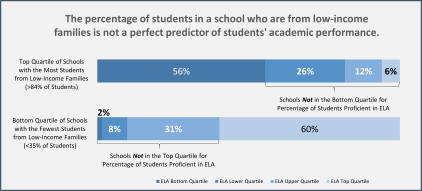High-Poverty Schools Must Have Poor Test Results? New York Data Show That’s Not the Case
Despite the U.S. Department of Education removing some of the so-called “high stakes” attached to standardized tests by waiving accountability requirements under the Every Student Succeeds Act (ESSA) for a second straight year, many states have continued to seek federal waivers from ESSA’s statewide assessment requirements, reflecting the ongoing debate over whether states should administer the annual tests during the pandemic. Unlike local assessments, statewide assessments are aligned with state grade-level content standards, peer-reviewed, and more accessible for students with disabilities and students learning English—and they provide results that are comparable across districts.
While opponents make many arguments against testing, some have suggested that state and local leaders, educators, and families do not need the data from statewide assessments—even for the purpose of allocating resources—because test results are strongly linked to students’ demographic characteristics and do not provide any new, meaningful information. For example, a letter from Rep. Jamaal Bowman (D-NY) and five other members of Congress to Education Secretary Miguel Cardona argued that “this type of assessments more reliably measures socioeconomic status than student achievement.” Instead of giving statewide tests, they argued, education leaders can look at other types of data, such as attendance and access to high-speed internet, to “readily identify those most at risk of learning loss.”
States and districts certainly should look to many different types of educational data when making decisions about how to support students’ academic, social, and emotional recovery from the pandemic—including the opportunity to learn data cited by Rep. Bowman and his colleagues. However, data from statewide assessments are an important piece of the puzzle, especially when it comes to allocating funding intended to improve students’ academic success, such as the 7% of state Title I funds dedicated for school improvement and the new 5% set-aside of state funds and 20% set-aside of district funds under the American Rescue Plan Act (ARPA) to address learning loss. In spending the new ARPA funds, states and districts need comparable, high-quality assessment data on student learning to figure out where learning loss is most severe, as opposed to guessing which students are most at-risk academically.
It is unfair to assume that poverty, or any other student demographic characteristic, is inextricably linked to lower academic achievement. To demonstrate this point, we looked at enrollment and achievement data from the 2018–19 school year for 3,144 elementary and middle schools in New York state. First, we sorted schools into quartiles based on the percentage of students in each school who were proficient in English language arts (ELA). We then sorted schools into quartiles again based on the percentage of students in the school who were from low-income families.
We found that New York schools serving a large share of students from low-income families were not necessarily the lowest-performing ones. Specifically, among schools that ranked in the top poverty quartile and served the most students from low-income families, nearly half (44%) were not in the bottom quartile for ELA performance, contradicting the idea that high-poverty schools can be automatically categorized as low-achieving. Additionally, two in five schools with the lowest percentage of students from low-income families did not rank in the top quartile for ELA achievement. Therefore, assuming low-poverty schools do well academically may deprive low-achieving students in these schools the opportunity to get the resources they need.
In order to build an equitable recovery for students, we should collect assessment data along with other educational data to make decisions free from false assumptions and biases. It is not either/or, it is both/and.

